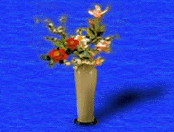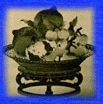
![]()


![]()

Flower arrangement among the common people had its origin in the religious pratices of early times and came to enjoy great popularity on both New Yearns day and other holidays, Popular compositions found on the ancestral altars in the central halls and chambers of households emphasized such themes as thanksgiving to benevolent gods, ancestor worship, appeals for good fortune, and the exorcism of ghosts and devils. Such compositions contained brilliant, eye-catching hues and colors and were, stylistically, the antithesis of the sedate, reserved literati arrangements. Flowers in common use included the peony, lotus, mei flower, chrysanthemum, orchid, camellia, jui hsiang, and rose. Among those chosen for their special significance were the cockscomb, the tuberose, the Chinese evergreen, and the cherry apple, each in its own season or bloom. Color combinations were complex and variegated, with compositions containing from three or four to more than a dozen different colors. Even arrangements with a limited number of flowers strived for as great a variety of color as possible. The same striking contrasts were sought in the materials and designs of receptacles and vessels, in combination with decorative knotting or calligraphic scrolls.These also helped to accentuate the distinction between the vibrant folk flower arrangements and the subdued, stately hues of the literati school.
![]()
White jasmine and gardenias, considered the most fragrant of flowers,
have long been used in offerings to the Buddha. In this composition, gardenias
are loosely arrayed in a square-shaped plate. To the upper right stands
an ancient square-shaped wine vessel containing two pansies and two longevity
chrysanthemums. The speckled interplay of color evokes the fresh beauty
of early summer.
![]()


Analyzed from the standpoint of the three major schools of calligraphy
- standard, running, and grass script - this composition would probably
be placed in the last category. Grass-style flower arrangements are noted
for the twisting, sinuous structure of their leaves and branches, and for
a high degree of inclination from the vertical. In this arrangement the
slanting lines draw the viewer's attention toward the position of an imaginary
sun. Overall, the impressionist and romantic influences are kept in check
by a tight linear discipline, conveying an impression of "controlled
chaos."
![]()


Analyzed from the standpoint of the three major schools of calligraphy
- standard, running, and grass script - this composition would probably
be placed in the last category. Grass-style flower arrangements are noted
for the twisting, sinuous structure of their leaves and branches, and for
a high degree of inclination from the vertical. In this arrangement the
slanting lines draw the viewer's attention toward the position of an imaginary
sun. Overall, the impressionist and romantic influences are kept in check
by a tight linear discipline, conveying an impression of "controlled
chaos."

![]()
[preface] [
styles] [religious] [palace]
[literati] [folk]
[9 pricniples] [significance]
[preveration] [vessels]
[appreciatin]
[Pavilion of Taiwan,
R.O.c] [Cultures]
[Council For Cultural
Affairs]